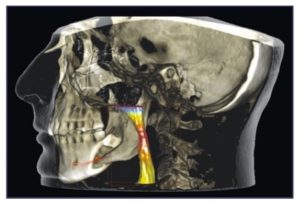
Years ago, I completed advanced training in neuromuscular dentistry. This was because, as an advanced care dentist, I desired to enhance our patients’ cosmetic dentistry and restorative procedures with the advantages of optimal “occlusion.”
Occlusion describes the intricate balance between the alignment of teeth and its supporting structures. In biting, chewing, speaking or even in a ‘resting’ position, proper occlusion gives patients an ideal outcome for the life and function of the work we do.
When we think of a smile, most people think of their “teeth held in gums.” Yet, it’s the bone structures covered by gum tissue that actually has the most significant role in overall oral health.
The teeth are ultimately supported by the upper and lower jaws. The upper jaw is known as the maxilla. The mandible is the lower jaw. The joints, muscles, nerves, and surrounding structures have much to do with whether there is a harmonious balance, or not.
Connecting the lower jaw to the skull is the temporomandibular joint (TMJ). These are on each side of the head, just in front of the ears. They each function like a sliding hinge, combining a hinge action with sliding motions. Each joint has a cushion of cartilage with a shock-absorbing disk. This padding helps provide a fluid, tension-free movement.
When the bite is misaligned (mal-occlusion) – meaning the upper teeth do not meet properly on lower teeth – it can lead to stress within these joints. The joints can wear down over time along with the surrounding cushioning components.
Although bite misalignment may never cause problems, some people develop a number of issues over time. For example, a misaligned bite is typically the cause of night-time clenching or grinding of teeth (bruxism). It can also cause jaw pain, worn or chipped teeth, and ear ringing.
In many cases, the pain and discomfort associated with TMJ disorders may be relieved with nonsurgical treatments, such as oral appliances (referred to as mouth guards, bite guards, aligners, etc.). Orthodontics may be needed in more complex situations. Surgery is typically a last resort if conservative measures have failed.
Signs and symptoms of TMJ DISORDERS include:
• Frequent headaches and/or migraines
• Facial pain and tenderness in the jaw or jaw joints
• Aching pain in and/or around the ear
• Ear ringing, dizziness, feeling off balance
• Difficulty chewing, opening or closing the mouth
• Clicking sound when opening the mouth
• Tingling in the fingers or down one or more arms
I was recently reviewing the symptoms of fibromyalgia and noticed a number of similar symptoms associated to TMJ disorder.
Fibromyalgia is a condition that causes widespread pain, sleep problems, fatigue, and emotional and mental distress. It affects about 4 million U.S. adults. Its cause is not known. (https://www.cdc.gov/arthritis/basics/fibromyalgia.htm) According to the Centers for Disease Control & Prevention (CDC), people with fibromyalgia may be more sensitive to pain than people without it due to “abnormal pain perception processing”.
The most common symptoms of FIBROMYALGIA are:
• Pain and stiffness of the body
• Fatigue and tiredness
• Pain in the face or jaw, including TMJ disorder
• Headaches, including migraines
• Depression and anxiety
• Sleep problems
• Problems with thinking, memory, and concentration
• Tingling or numbness in hands and feet
Because some of the symptoms of TMJ disorder are seemingly unrelated to one’s bite alignment, it is sometimes able to mask itself as neurological, ear, eye, and muscle issues. Some people are even told “it’s all in your head,” being brushed off as mental issues (at times being given anti-depressants to “treat” it).
As a neuromuscular dentist, I’ve treated many patients who have suffered for years – even decades – with TMJ disorder. Some have gone from doctor to doctor, seeing specialist after specialist, only to get very little to no relief. They’ve had costly tests and expensive therapies, only to experience minimal (if any) results.
In our Macomb County dental office, we have incorporated some of the most advanced diagnostic technology in the U.S. when it comes to TMJ issues. In addition to specific testing of the muscles at various points in bite alignment, we use highly-advanced cone beam imaging technology.
This low-dose radiation 3D imaging reveals airway passages, jaw joint structures, surrounding bone depths and muscle/tissue connectivity. These intricate views take the guesswork out of “IF” a TMJ disorder truly exists and “IF SO,” where the issue lies.
TMJ disorders can often be conservatively resolved. For most, we utilize a fully customized approach in reshaping selected teeth, the placement of crowns, and/or creating custom-contoured oral appliances that can be comfortably worn at night. These small mouth pieces are often effective in alleviating the symptoms associated with TMJ issues.
When appropriate, we have an orthodontic specialist on our team. For adults and teens who prefer, we also offer Invisalign “clear braces.” Unlike traditional braces that use brackets and wires to move teeth into proper alignment, Invisalign uses “invisible” molds that ease teeth gently and comfortably.
Some dental offices in the Oakland and Macomb County area offer oral devices to help adjust the bite non-surgically. However, few are able to offer the combination of neuromuscular dentistry and technology that provides measurable results.
As a matter of fact, we have had some patients come to our Shelby Twp, MI dental office from other states. The ability to get a true, accurate diagnosis and relief from symptoms – symptoms that can become debilitating over time – is (as one patient put it) “well worth flying into the Detroit area in order to get my life back!”
If you are experiencing issues you feel may be related to your bite or TMJ, we offer a no-cost, private consultation. During this time, we will discuss your specific symptoms and the process of diagnosis and potential treatment.
Call 586-739-2155 or tap here to begin.